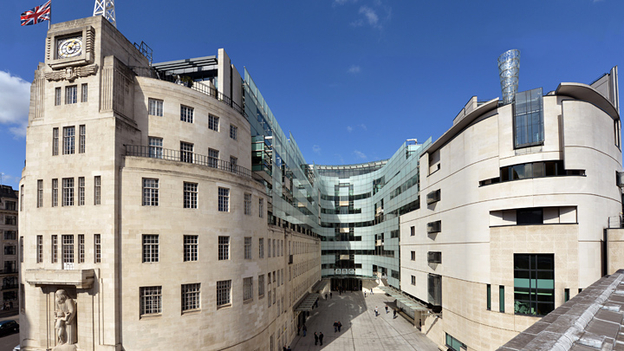The co-ordinates take you to the street beside the new east wing of the BBC's Broadcasting House. It is a building of steel structure, faced in Portland Stone. Historically, Portland Stone has been the most widely used of the Jurassic limestones of Britain. It is arguably the principal building stone of London, at least since the post-medieval period, and became popular in the 17th century following the demise of timber as the predominant construction material, particularly after the Great Fire of 1666. It was in such demand in the 19th century, that railway lines were built from the quarries to speed up and ease transportation to the cities and major towns of Britain. Before that time, much of the transportation had been via sea and the canals. It is a durable, light-coloured stone and suffers relatively little from weathering in comparison to other building stones such as sandstone.

Construction of the old Broadcasting House (seen on the left of this image) began in 1928 and the building was inaugurated in 1932. The east wing extension (seen on the right) was completed in 2005 and was designed to mirror and complement the architecture of the original building. Both wings are faced in Portland Stone. The original wing is faced in Portland Whitbed and the new wing is faced in Whitbed (at higher levels) and Portland Roach at lower levels.
Portland is a relatively pure limestone containing, on average, 95 per cent calcium carbonate. It was formed at the end of the Jurassic period, around 145 million years ago when what is now the Isle of Portland (approx 150 miles south-west of London), was much closer to the equator than it is today. It is creamy white in colour and is an oolitic limestone but the ooliths (spheres) are not readily visible. The stone occurs in distinct beds known as Portland Base Bed, Portland Whitbed and Portland Roach. Fossils are prominent in most Portland stone and, as natural weathering occurs, the harder fossils tend to stand proud of the surrounding matrix.
Portland Roach
The bed with the most obvious fossils is Portland Roach, which has large shell fossils and bears the concave imprints of those which have been lost. Many of the classic fossils of the Portland Stone can be seen in the blocks used in the east wing. Most prominent are the casts and internal molds of Portland Screws, Aptyxiella portlandica and the grey oysters whose calcite shells have remained intact. Also present are other bivalves including casts of Laevitrigonia gibbosa, with ribbed and knobby shells, Protocardia sp, a cockle and Plicatula sp., a spondylid (spiny) bivalve. The holes are due to the removal of fossil shells by percolating rain.
Portland Whitbed
Portland Whitbed is quarried from below the Roach. The noun “Whitbed” is almost certainly a corruption of “white bed”. Whitbed is a lightly-coloured fine grained, mainly oolitic limestone typically containing a proportion of comminuted shell fragments, ranging between ~5 mm and ~50mm in diameter. Whitbed can yield an excellent freestone suitable for all external work. Fossils are less obvious in the Whitbed stone which was used to face the original building. During the Second World War, the building's bright white facade was painted dark to make it harder for aircraft to target. It was still hit three times.
Your tasks
To log this cache, you will need to complete the tasks below. You can use information from the cache page and your observations at GZ to do this. Please message us with the info (rather than post it on your log). You can log a find once we have been sent a message; there is no need to wait for a reply. We may delete your log if your answer is way off the mark.
- Look at the stone used on the 'old' building (the Whitbed) and on the rounded end of the new wing (the Roach). How do they differ from each other?
- Examine the Roach (on the new wing) and describe the fossil casts and molds you can see. (Size, shape etc.) Which of the fossil casts do you think are the Portland Screws?
- Why do you think that Portland Stone was the stone of choice for the BBC Broadcasting House?
- As an optional extra, post a picture of yourself and / or your GPSr next to the new wing of the building with the Portland Roach in the background.